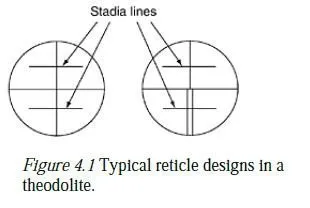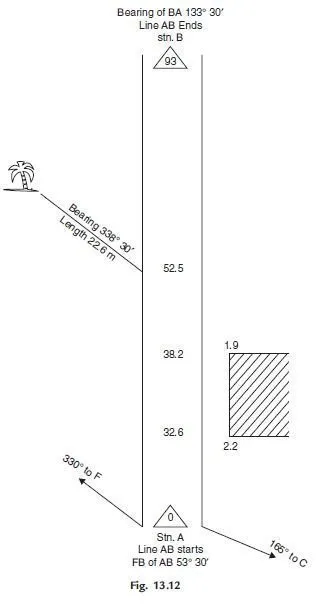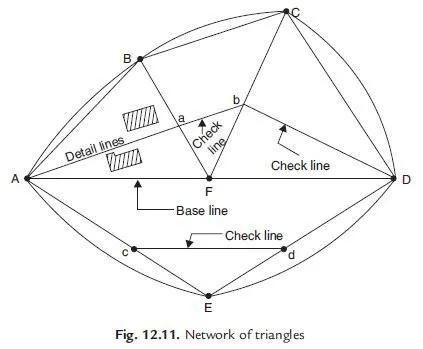10.5 Leastsquares adjustment by computer
The mathematical methods described in the preceding two sections are clearly more suited to computer programs than hand calculation though it is worth remembering that the adjustment of the first-order control points in OSGB36 was done by hand, using mechanical adding machines to handle the numbers! Several programs are available for the least-squares adjustment of both conventional and GPS surveying data; one such is LSQ, which was developed in the Cambridge University Engineering Department for student use and is included with this book. LSQ is essentially a batch program which processes an input file of control points and observations, to produce a results file of residual errors and likely positions for the adjustable points. The observations are all processed in a grid system, as opposed to being converted to geographical co-ordinates for processing and back to grid co-ordinates afterwards. This means that reduction to the spheroid, scale factors and (t−T) corrections must be applied to the measured distances and angles; LSQ takes these into account when calculating the observations that would result from the current positions of the adjustable points, which it then compares with the actual observations to find the residual errors. Any adjustment program which accepts vertical angle observations must either make corrections for atmospheric and earth curvature effects itself, or require that the observations are corrected before entry (see Chapter 12). LSQ takes the former path, so that raw input data can be used. As Section 10.3 shows, the adjustment method only converges reliably if the adjustable points are in approximately the correct positions at the start. Thus, the iteration in LSQ may fail if the initial guesses for adjustable co-ordinates are poor, or if some observations have large gross errors in them. The format for the input data, the facilities for finding errors in the data and maximising confidence in the results are fully explained in the user manual, which forms the help system for the program. A sample adjustment using LSQ is given in Appendix E.
10.6 Interpreting leastsquares results
The results of any least-squares adjustment should be inspected carefully before they are accepted. In particular, the following points should be checked:
1 Check that the standard deviation of the weighted residual errors (the ESD scale factor in LSQ parlance) is reasonably close to unity. If it is greater than about 1.5, it means you have either been excessively optimistic in your estimate of likely standard deviations for the readings, or that there is at least one non-random error amongst the data. Try eliminating the observation which has the largest weighted error and running the adjustment again. If everything works well this time (and there are still enough readings to provide redundancy), it means that there was almost certainly a gross error of some kind in that observation.
2 If the ESD scale factor is less than about 0.7, then you may have been overly pessimistic in your estimates of the likely error present in each reading. Alternatively, it may be that there are not enough suitable readings to fix the unknown points with sufficient certainty; a large number of adjustable points which are only loosely tied into two or three distant known points may produce a very stiff-looking network which is not, in fact, very well constrained. There is always a statistical possibility that the random errors have, in fact, all come out close to zero. However, the probability that errors are present but are hidden because they appear to cancel out will always be greater.
3 If the ESD scale factor is around unity, check that the distribution of the weighted errors is similar to what would be expected from a normal10 distribution. Typically, 2/3 of the weighted errors should be less than unity, about one in 20 should be greater than two and virtually none greater than three. If the distribution differs significantly from this profile, further investigation is called for.
4 If the program has the facility, check that there is still redundancy in the remaining data but note that it is possible to falsely simulate redundancy, e.g. by including some observations twice in the dataset.
5 If the program has no redundancy check, then check that no weighted error is exactly zero. If one or more is, then it almost certainly means that there is no other measurement in the data to provide an independent check of the quantity which it is measuring in other words, there is no redundancy in that part of the scheme.
6 Finally, check that the sizes of the error ellipses are acceptable. If an error ellipse has a large eccentricity (i.e. it is long and thin), it indicates that the point is well fixed in one direction but poorly fixed in another (see the example in Section 2.3). Further (and different) observations will then be needed to improve matters and make the error ellipse more circular. Note that the shape of the error ellipses is principally determined by the geometry of the observation scheme, rather than by the accuracy of the measurements themselves. The shapes of the ellipses can in fact be found without taking a single measurement, provided the likely relative accuracies of angle and distance measurements are known. Thus, the best set of measurements to produce near-circular error ellipses can (and should) be determined at the planning stage, and a highly eccentric ellipse in the results probably means that the planning was poorly done.
10.7 Summary
Least-squares adjustment is a powerful tool for the surveyor, but needs to be used with care and skill to produce reliable results. A few final guidelines are:
1 Make sure you have planned to take enough observations to fix each and every variable in the adjustment with some degree of redundancy simply having more observations than unknowns is not necessarily sufficient.
2 If possible, use the adjustment package before any measurements have been taken, to ensure that the intended measurements will produce well-shaped (i.e. near-circular) error ellipses. Most least-squares programs (including LSQ) have the ability to be used in this planning mode the details of how to do so will depend on the package used.
3 Most least-squares programs will require initial guesses for the positions of the unknown points. Make reasonably precise initial guesses for these, such that the initial calculated angles will not differ from the observed angles by more than about 20°. If this is not done, the iteration may not converge.
4 Be very careful when mixing horizontal adjustments with vertical adjustments. It is hard to get the relative accuracy weightings of the two types of observations correct, and distortions can result. It is often easier to do height adjustments by hand (as these are relatively simple) then do horizontal position adjustments using the least-squares program, with the heights fixed. In particular, avoid fixing heights using slope distance measurements; if the observed distances are nearly horizontal (as is usually the case) then small errors in the measurements will cause large errors in the height differences.
5 Be careful not to exclude any observation for no better reason than that it appears to disagree with your other observations. Being selective in this way can lead to a totally false indication of accuracy in the final result. It is of course perfectly acceptable to investigate such an observation further, to see whether there was some reason why it may not have been as accurate or reliable as the other observations. If you already have another measurement of the same observation which fits the other observations better, then it is probably safe to reject the problematic one; if you do not, you should ideally go and measure it again.
6 Sometimes, the quality of data for the known points may not be as good as you have been led to expect, and this may result in some of your observations appearing to disagree with each other. If you suspect this to be the case and you have enough readings, you may be able to identify possible errors in the known data by making the known points stiff rather than rigid, and seeing whether the quality of the result suddenly improves. Again, further observations may be necessary to confirm this to an acceptable level of confidence.
7 Check all results against the criteria listed in Section 10.6 before accepting them.



